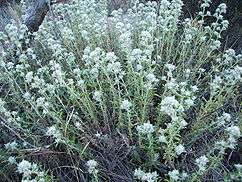Teucrium polium
| Felty germander | |
|---|---|
 | |
| Teucrium polium L. subsp. capitatum (L.) Arcang. | |
| Scientific classification | |
| Kingdom: | Plantae |
| (unranked): | Angiosperms |
| (unranked): | Eudicots |
| (unranked): | Asterids |
| Order: | Lamiales |
| Family: | Lamiaceae |
| Genus: | Teucrium |
| Species: | T. polium |
| Binomial name | |
| Teucrium polium L. | |
| Synonyms | |
| |
Teucrium polium, known popularly as felty germander, is a sub-shrub and herb native to the western Mediterranean region (Albania, Spain, France, Algeria, Morocco, Tunisia).[1] Its flowers are small and range from pink to white, and its leaves are used in cooking and for medicine, particularly for the treatment of stomach ailments. It has also shown some promise in the treatment of visceral pain. In traditional Persian medicine, T. polium (locally called 'kalpooreh') is used as an anti-hypertensive, anti-bacterial, carminative, anti-nociceptive, anti-inflammatory, anti-diarrhea, anti-diabetes and anti-convulsant agent. A scientific study in 2003 failed to find any benefit to diabetics, even though it is commonly used in the mideast for this purpose. A scientific study in 2006 found that it does have anti-nociceptive and anti-spasmodic effects. Caution should be applied with use of this herb due to its known liver and kidney toxicity.
References
External links
- Felty germander page at Annie's Annuals
- The Effect of Extract of Teucrium Polium On Blood Sugar and Insulin Levels of Type 2 Diabetic Patients. Shiraz E-Medical Journal Vol. 4, No. 4, October 2003
- Anti-Spasmodic and Anti-Nociceptive Effects of Teucrium polium Aqueous Extract. Iranian Biomedical Journal (IBJ) July 2006
- Abstract: Antinociceptive effects of Teucrium polium L total extract and essential oil in mouse writhing test